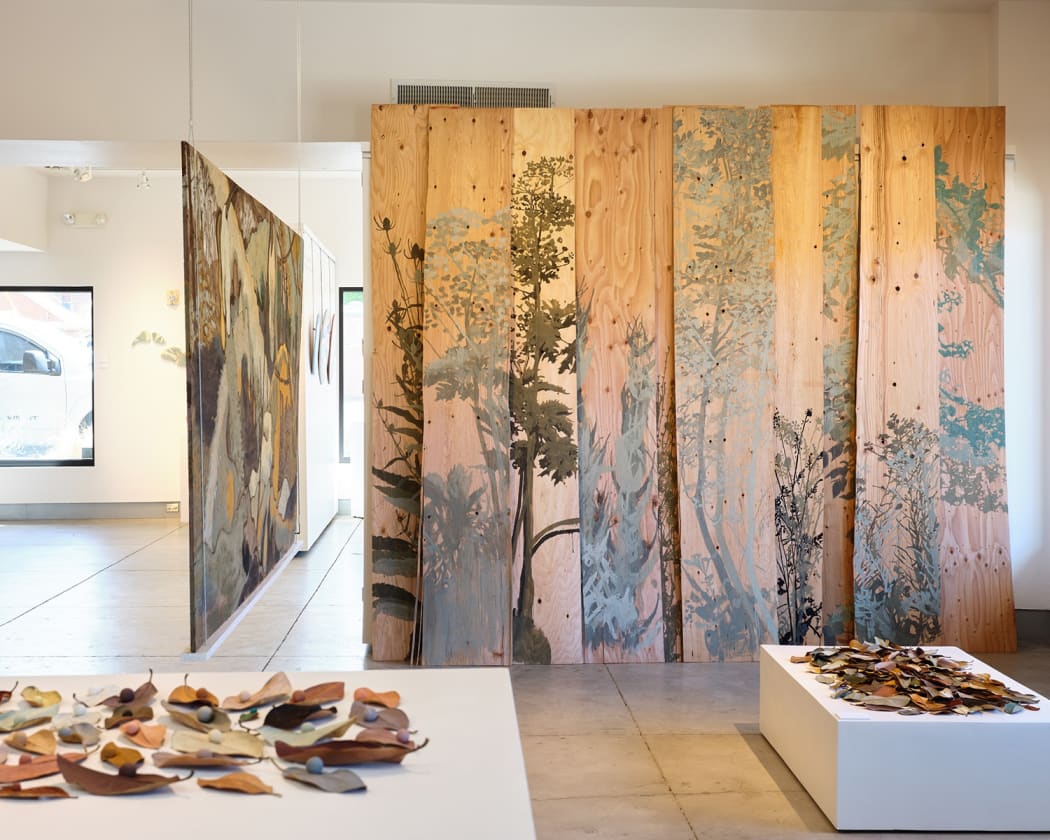
DIRECTOR'S NOTE
For many of us, climbing trees is an experience exclusive to childhood. As our backs grow stiffer, we come to believe that engaging in such an activity as an adult might be improper or dangerous. Records of Being Held is a reintroduction to the tree as a unified being that is also an infinite series of cradles and portals. A bough can hold the human body with incredible firmness, and it can also visually carry a marvelous beyond of hills and valleys in its crook. Remember?
- Jordan Eddy, Director
ARTIST STATEMENT
Records of Being Held is a series of six personal memories of place temporarily held in foraged mineral pigments (with occasional egg and cherry gum binder) on three sheets of plywood recovered from construction sites in the Eugene/Springfield region of so-called Oregon.
Paint, as a living and energetic collaborator, and as an embodiment of the soil, rocks and plants that make up the places that hold me, works with me to leave a record of my experience of bodily and sensory intimacy with that place. These records, which communicate to the full sensorium through their materiality, render the way that eyes carried by a body in constant motion and motivated by sensory exploration register the memory of place.
The pigments themselves are in flux, in motion, each carrying a unique geological history and chemical presence, as evidenced by their range of colors, textures, scents, and even the sounds they produce when crushed or stroked. As occupants of the surface layers of the ground, these mineral and botanical pigments are witnesses to the life histories that have passed over them, many thousands of years of multispecies relationships and human histories of both caring for landscapes and disregarding them.
These large painted records are intended as evidence of my physical intimacy with specific places, rather than as representations that act as windows into sublime landscapes. Countering the tradition of "capturing" a landscape through the formal distillation of its visual beauty, these records are instead offered as temporary collaborative performances with materials, conjunctions that will dissolve and evolve.
After a contractually agreed upon term, the paint will be washed off by me and other members of the pigment community, gathered up to be further engaged through future performances, and eventually ritually returned to the sites where they were gathered. Instead of exchanging moneu for ownership, "collectors* become collaborators, enacting these further pigment futures by stepping into relationship with the pigments themselves, their landscapes, their ancestral custodians, and their multispecies communities, as well as with form & concept, me, the artist, and the larger pigment community.
The plywood boards, made from trees grown near these sites, and intercepted from the waste stream, will remain in possession of the buyer as palimpsests of their participation in this record-keeping, along with hand-woven, pigment-reclamation cloths, once their pigment-returning functions are complete. One exception, Family, composed of 47 Ground Bright pigments, will direct all 'rent" monies to the Wild Pigment Project Equitable Opportunity Fund, and the reclaimed pigment will be sold through the project to raise additional funds for this purpose.
ABOUT THE VISUAL LANGUAGE OF THE SERIES
As a lonely child of busy parents, I sought solace in two things: Saturday morning cartoons and my rambles in fields and woods. In the first I found a noisy, peopled, technicolored world built by hand through imagination and creative freedom, which punctuated the grey stillness of the quiet, early-morning house. In the second, I found the listening ears and reassuring presence of the interspecies community, a living playground that engaged my body and my longing for companionship.
Looking at art was a bonding activity for my family, and in the many museums we visited together, I found my gaze predictably drawn to the scenes behind the figures: the tiny landscapes in Da Vinci's blue distances, the cones of hay on the outskirts of Bruegel's villages, the strange twisted trees in Bosch's paradise. I wanted the trees and the boulders to be more than just backgrounds, to be featured as personalities, capable of dialog and participation, instead of mute support for humans. I wished that these aspects of the scene were the painters' central subjects rendered life-sized, ready to offer themselves to me to step into as I did on my solitary rambles.
Saturday morning cartoons taught me that animation - the act of bringing drawings to life - could convey personality regardless of form. The culture that raised me also taught me that these two things I loved - the wonders of animation, and the experience of communicating with the interspecies community - were activities reserved for children, and not of «the real world."
The impulse to validate both imaginative drawing and a communicative relationship with the interspecies world as crucial adult activities drives this series. Records of Being Held is designed to substantiate the presence of the living world and its many forms as not just "actants" - beings capable of playing imaginary roles - but "interactants": beings with agency capable of interaction and collaboration.
A NOTE ABOUT KALAPUYA ANCESTRAL PIGMENT PRACTICES
Ancestral knowledge of Kommema Kalapuya mineral pigment use was destroyed through cultural genocide, says elder Esther Stutzman. Kalapuya cultural objects are primarily plant-based, she explains, so most colorants were likely to have been botanical, but, she says, it's also quite possible that ochres were used for the ornamentation of baskets and other weavings. There is a small number of ancient pictographs made with ochres on Kalapuya territory, as well as one made using green earth.
Although the Records of Being Held series will be offered for purchase, the pigments themselves will be available for “rent” only, with an annual fee paid at the time of the initial purchase to the Kommema Cultural Protection Association, an organization led by Kalapuya elder Esther Stutzman, currently rematriating an area of ancestral Kalapuya lands in the region where these pigments were gathered.
-Tilke Elkins